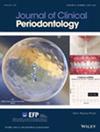用scRNAseq表征牙周肉芽组织
IF 6.8
1区 医学
Q1 DENTISTRY, ORAL SURGERY & MEDICINE
引用次数: 0
摘要
目的利用单细胞RNA测序技术(scRNA - seq)研究牙周肉芽组织形成的细胞组成和分子机制,为牙周病的发病机制和再生治疗的潜在靶点提供科学依据。材料与方法收集3例牙周手术患者的肉芽组织标本。将新鲜组织加工成单细胞悬液并进行scRNA测序。将这些数据与健康牙龈和牙周韧带的现有数据进行整合和比较。通过免疫荧光染色进行计算分析和验证。结果在样品中鉴定出不同的细胞群。与健康组织相比,肉芽组织显示出更高的免疫细胞丰度。一个新的内皮细胞亚群,肉芽组织所独有,被发现并以NOTCH3表达和参与骨化途径为特征。此外,肉芽组织成纤维细胞亚群表现出类似祖细胞的状态,其特征是细胞外基质重组和低分化,类似于癌症相关成纤维细胞。本研究发现了一种新的内皮亚群,为该疾病的发病机制提供了新的见解,并为再生治疗提供了潜在的靶点。这些发现将有助于促进对牙周病肉芽组织形成的理解,并为开发调节特定细胞通路的材料提供信息,以改善牙周病的管理。本文章由计算机程序翻译,如有差异,请以英文原文为准。
Characterising the Periodontal Granulation Tissue Using scRNAseq
AimTo investigate the cellular composition and molecular mechanisms of periodontal granulation tissue formation using single‐cell RNA sequencing (scRNA‐seq), aiming to enhance the understanding of periodontal disease pathogenesis and identify potential targets for regenerative therapies.Materials and MethodsGranulation tissue samples were collected from patients undergoing periodontal surgery (n = 3). Fresh tissues were processed into single‐cell suspensions and subjected to scRNA‐seq. The data were integrated and compared with existing datasets from healthy gingiva and periodontal ligament. Computational analyses were performed and validated through immunofluorescence staining.ResultsTen distinct cell clusters were identified across the samples. Granulation tissue exhibited a higher abundance of immune cells compared to healthy tissues. A novel endothelial cell subpopulation, exclusive to granulation tissue, was discovered and characterised by NOTCH3 expression and involvement in ossification pathways. Additionally, granulation tissue fibroblast subpopulations demonstrated a progenitor‐like state, characterised by extracellular matrix reorganisation and low differentiation, similar to cancer‐associated fibroblasts.ConclusionThis study identified a novel endothelial subpopulation offering new insights into the disease's pathogenesis and presenting potential targets for regenerative therapies. These findings will help advance the understanding of periodontal disease granulation tissue formation and provide information for the development of materials to modulate specific cellular pathways to improve periodontal disease management.
求助全文
通过发布文献求助,成功后即可免费获取论文全文。
去求助
来源期刊

Journal of Clinical Periodontology
医学-牙科与口腔外科
CiteScore
13.30
自引率
10.40%
发文量
175
审稿时长
3-8 weeks
期刊介绍:
Journal of Clinical Periodontology was founded by the British, Dutch, French, German, Scandinavian, and Swiss Societies of Periodontology.
The aim of the Journal of Clinical Periodontology is to provide the platform for exchange of scientific and clinical progress in the field of Periodontology and allied disciplines, and to do so at the highest possible level. The Journal also aims to facilitate the application of new scientific knowledge to the daily practice of the concerned disciplines and addresses both practicing clinicians and academics. The Journal is the official publication of the European Federation of Periodontology but wishes to retain its international scope.
The Journal publishes original contributions of high scientific merit in the fields of periodontology and implant dentistry. Its scope encompasses the physiology and pathology of the periodontium, the tissue integration of dental implants, the biology and the modulation of periodontal and alveolar bone healing and regeneration, diagnosis, epidemiology, prevention and therapy of periodontal disease, the clinical aspects of tooth replacement with dental implants, and the comprehensive rehabilitation of the periodontal patient. Review articles by experts on new developments in basic and applied periodontal science and associated dental disciplines, advances in periodontal or implant techniques and procedures, and case reports which illustrate important new information are also welcome.
 求助内容:
求助内容: 应助结果提醒方式:
应助结果提醒方式:


